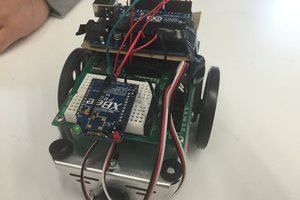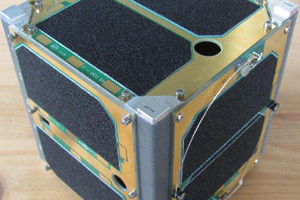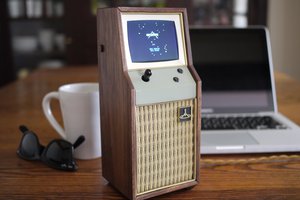NIRGM - Non-Invasive NIR Glucose Meter
Uses different wavelengths of light to shine through the skin in order to determine the amount of glucose present in the user's blood.
Uses different wavelengths of light to shine through the skin in order to determine the amount of glucose present in the user's blood.
To make the experience fit your profile, pick a username and tell us what interests you.
We found and based on your interests.
This is my vlog, but this one is focused on my NIRGM project, skip ahead if you're not into the whole "vlog" thing.
Adafruit featured my project today. I have received lots of emails pertaining to helping out with the project, Its really awesome! I need to clean up the project a bit and post it to GitHub so there is more access for everyone. I will admit I'm not the best when it comes to doing that, so I will try my best to get it all set up(Time is a huge factor). There are lot of people eager to help program, or gather data, so I need to get the design sorted out before I tell people to start building these!
If I have not emailed you back yet, don't worry, I'm making my way through them and will get to you eventually. They are all appreciated!
Thanks everyone!
Realized that I should have(a long time ago) ordered some high quality LEDs. The standard inexpensive ones I always get are not cutting it. Did a brief search on Digikey and found some serious ones for the job that should be a lot better and also are still 0603 so no need to order a new board.
Red:
http://www.digikey.ca/product-detail/en/APTD1608SEC%2FJ3/754-1542-1-ND/2514675
Green:
http://www.digikey.ca/product-detail/en/XZM2DG53W-8/1497-1162-1-ND/4745508
The IR and the NIR are already powerful enough I hope.
Create an account to leave a comment. Already have an account? Log In.
Is there any way to get the schematic and BOM ? I may modify this to use a raspberry pi zero, small oled display, ppg sensor, and low power IR LASER Diode. I would like to build it into a wristband.
I would really like to look at the schematic. It would be cool if we can pull this off because the current CGM technology is invasive plus the sensors and transmitters are not cheap. If we can enable anyone to build a non invasive CGM We will truly helping everyone who suffers from diabetes.
I believe we need to use a low power IR LASER as a light source here. This looks great. Any progress yet ? I can help design hardware and write code.
Hi
Kindly anyone can provide me real documentation of this project?
There is this project Universal Glucometer on Hackaday. It has a reference on a Crusade for noninvasive glucose meters. Please save yourself a lot of time, and read it. http://www.mendosa.com/The Pursuit of Noninvsive Glucose, Fourth Edition.pdf
Smith JL. 2015. The pursuit of noninvasive glucose: “Hunting the Deceitful Turkey”
from https://hackaday.io/project/10865/logs
Quote: "After more than thirty years of looking into noninvasive glucose technologies, I have
developed what may be an overly skeptical classification system for new ideas:
1. Holy cow, not this again! This technology has been investigated before (maybe five or
ten times), and the investigators have always run up against the same roadblocks.
2. An old idea revived by researchers who think they have discovered that the earlier
investigators “quit too soon,” or think they have a unique insight into why a
multiply-investigated idea failed each time.
3. This is a new and possibly unique idea, but there is no scientific basis on which it
could reasonably provide accurate glucose measurements.
4. This is something that has not been explored before, it has a reasonable basis in science
and, there is no a priori reason why it could not yield glucose results. I live for
these; a recent example of these was FoviOptics, where I came out of retirement
to spend two years of my life (and gained a substantial long-term capital loss tax
carryforward as a result of exercising options for founders’ stock) before learning
why it did not work. The point is that it could have worked!
5. This will work!
To date, I have seen hundreds of ideas that fall into categories 1 and 2, quite a few that fit
into category 3, and four or five in category 4. I am still waiting to hear of something in
category 5.
I am also interested in testing variances between my personal Blood testing and a NIRGM. I have read reviews of several commercial products, not many favorable. Costs did not justify being a Guinea pig.
That's such a nice project,but this bothers me a little bit.By what means can you get the training datasets?
The training data sets would be created by me. Testing my bloodsugar and taking light readings at the same time. It would only be trained to my skin/body, but it would prove the concept.
Sean, do you generate Clarke error grids in your testing? Just curious. I've just been diagnosed and want to get ahead of this disease.
one thing that would be necessary for testing the efficacy of this would be to intentionally let your glucose level drop and then spike (or spike and then drop), and test your devices ability to track in real time.
While this is a really noble goal, I feel like it should be very clearly stated in the project description that this same technique for non-invasive glucose measurement has been tried unsuccessfully for the last 30 years, and most people believe that it is not technically feasible to measure glucose in this way. The Adafruit article on this project included the following update:
"This it is not a functioning glucose meter- it is an IR/NIR transmissive optical sensor. This technology has been studied extensively for use as a glucose meter, but has never resulted in a product. There is no evidence that this platform is capable of measuring glucose. A comprehensive history of glucose measurement, including optical methods can be found here: http://www.mendosa.com/noninvasive_glucose.pdf"
While I do agree that it should be noted, it's not always the best way to start out an ambitious project by first stating that it's impossible. A lot of these studies have been conducted in the field of biology, and therefore have not had much experience with implementing new techniques of data analysis and classification. There is also a minimal amount of research done with regards to neural networks and deep learning which is specifically the direction the project is going. There has been recent success in a few studies which have led me to begin the project in the first place. I believe adafruit added the update as their original story was a little too promising as they did not say how much of a work in progress this was. It's only impossible until someone does it. You have to remember, I'm doing this project to improve my own life, not trick people into thinking I've created a new technique to measure blood glucose. I do believe that people should be revisiting all of these techniques in an open source way. The closed medical system has been broken for some time. I want to stir up the medical industry any way possible.
My current field of study has given me hope that there probably is a reliable ways to determine BG levels while not wasting a test strip. This is one of the ways I would like to investigate.
I typed this on my phone, sorry if it has errors etc.
Sean, where there's a will...there's a way.. Keep going! Where 300 people will tell you it's been tried and you can't do it that way... it only takes one to prove them all wrong. =)
How well does glucose monitoring work with only the red and green LEDs?
This is just amazing! Congrats for starting such a great project.
fyi - im working now on how to hack open a G4 transmitter to replace the batteries and document it for others, it is not easy. Very interested in your xDrip PCB project, I know many epople who will be helped by that
Very interesting. My daughter is diabetic, and my nightmare is her going hypo during the night. We've addressed that with the invasive and extremely expensive Dexcom CGM system, but I can see this project having huge potential to act as a low-cost alternative hypo alarm that could be accessible to many more people. I can imagine it being set to alarm when it starts seeing a low pattern, and being clipped to the ear might help wake even the soundest sleepers - my kid excepted, though; nothing wakes her up.
Have you given any thought to not going for an absolute BG value, but rather just a relative reading? Just seeing which way the BG value is going might be enough for a simple alarm.
I have been thinking about getting a CGM for some time now, haven't gotten around to it. I'm glad you're able to provide one for your daughter. I was able to save my parents from that fear in that I developed my T1 when I was about 21. I've actually been looking into hacking the Dexcom system, maybe designing my own transmitter, since the one Dexcom sells is $700 without replaceable batteries.
Have you heard about #xDrip (formerly #DexDrip)?
http://stephenblackwasalreadytaken.github.io/xDrip/
Allows you to have multiple devices listening in on the Dexcom so BG values can be relayed to an online server and/or another device. You could set things up say to text your phone, or have an alarm at certain events. Heck you could take an ESP8266 and make the lights in her room flash on and off when she goes low(okay that might be a little bit disorienting heh). I'm working on a board to make it easier for people with no soldering or electronics skills to also get setup. I should make it into a Hackaday.io project(and I will now haha).

All the real legwork has been done by way more talented people than myself. I'm just contributing what I can by making the board. The whole thing was already designed component wise by Steven, the dev. of xDrip. I figured it could be done cheaper with a single board instead of individual off the shelf hobby electronic stuff. Its a TI CC2511 with an HM-11 Bluetooth module, and just does basic things like have on-board battery charging and stuff like that. Right now the issue is with the bootloader. The code uses the Wixel bootloader from pololu which isn't open source. So it will need to be ported to the open source bootloader for the CC2511, or just programmed directly.
I like how I get off topic in the comments on my own project page. Haha
Yeah, jeez OP, way to jack your own thread, lol.
Good stuff on xDrip, thanks. We got upgraded to a Share for $200 hoping they'd release the Android app soon. No dice so far, so xDrip might be the way to go.
Good luck with the project, I'll be watching closely. Toying with my own Hackaday.io project on purifying insulin from raw pancreas should the need ever arise. A woman kept her diabetic husband and lots of other folks alive in the Warsaw ghetto in WWII by harvesting water buffalo pancreata. Might make a neat project if I can keep the feds off my back.
Hey,
That's such a nice project. It's so cool when people build something usefull.
I guess a lot of people could benefit of this.
What's exactly the problem with determining the glucose level? Are readings unstable during one measurement or do they differ every day/hour? I think people (me, me, me) would love to help you out if you have some more info about it.
regards,
Cor
The issue comes from trying to determine the volume of glucose containing liquid that is actually seeing the NIR light. Since this amount varies so widely between each reading(placement of sensor) then its really difficult to know you're just looking at less blood, or your blood sugar is just lower. Plus the range in the light reading is really small, so that become a SNR problem as well.
I have been receiving lots of emails from people offering help, which is awesome. I'm in the process of making the project clean enough to put on GitHub, so everyone can have a chance at playing with it. I have also been toying with the idea of setting up a small batch of assembled sensors for those not interested in surface mount soldering. So I will have to see the interest in people willing to put some funding into that. It would be great to get a bunch of these into the hands of some willing programmers to test out their skills.
How does the device work now? Does it use all of LED's mentioned during one measurement? I can't make that out from the description or the pictures.
The visible light LED's should give you some idea of how much stuff is in the way right?
Can you already measure your heart rate from the data?
I guess you can compare your readings to the finger prick test. And then see if you can find some correlation. It's a tricky problem for sure.
I hope it's a similar problem as measuring the oxygen in your blood:
http://en.wikipedia.org/wiki/Pulse_oximetry
I hope to see updates on your project :)
Yeah I need to make a good details section, but in a nutshell... The Green LED glows and you take that reading, using this value you can determine the thickness of all of the stuff in the way(skin, blood, fluid), then you use the Red and IR LEDs in a similar fashion of calculating Blood O2, use this to determine there is enough blood present to do the test. Using those value you can calculate the volume of blood between the sensor and the LEDs. Finally you shine the NIR 1550nm LED through, and knowing how much blood there is, you can determine the amount of glucose by reading how much 1550nm light gets though(Glucose absorbs the 1550nm). This all happens per measurement. You get heart rate and o2 levels as a byproduct of taking the glucose measurement, so that is cool.
Yes, if I get some firmware up and running, I can test me ear every time I use a test strip, which is multiple times a day, and slowly build my own personal data up.
Are you using one photodiode for all readings (green ~550nm to nir 1550nm)? It is a dual band one ? I can't find a photodiode with such large range.
Saw a write up on this in my news feed. I'm also working on a non-invasive continuous blood glucose monitor #BloodWatch (not much progress as yet; impatiently waiting on parts). It uses a different technique (dielectric spectroscopy), but we do share one similar challenge; extracting a signal (glucose level) from noisy/erratic data. I was planning on throwing the problem at a deep-learning neural network. This approach might work for you too. Ideally you would feed it with lots of raw data including reference readings - using an invasive continuous monitor, recording the data from your sensor and correlating the two for training.
Awesome! I will keep an eye out for your project. I am also planning on using a neural network, or possibly deep learning. The office where I am doing my masters is using a lot of these techniques for some of the research, and the last three classes that I took were on NNs, deep learning, and cognitive systems. I'm glad we are on the same wavelength there. Ill check out dielectric spectroscopy as well, sounds interesting.
Your insulin temp logger was a cool project, check out my insulin pen cooler. Its in the works and sort of an off hand thought that may or may not work. Going to give is a shot though.
https://hackaday.io/project/5161-portable-insulin-penbottle-cooler
This project amazes me. As a diabetic myself and my wife is hypoglycemic a non-intrusive glucometer would be amazing.
A reliable device is the dream... For me its not even the fact of having to sample blood, its the nuisance and the inconvenience of the process. If I could just stick something on my ear while I'm riding and get a read out, it would just make some things so much easier.
Yep, I usually throw one of those on most of my projects.
Become a member to follow this project and never miss any updates

 andrew.powell
andrew.powell
 Lorin Briand
Lorin Briand
 sparks.ron
sparks.ron
 Mike
Mike
Hi Sean, what kind of theory are you using for measure blood glucose level. how do you convert voltage into mg/dl ? skin and blood thickness is different someone to someone. also how do you eliminate other component in blood (Ex:water, if any infection)?